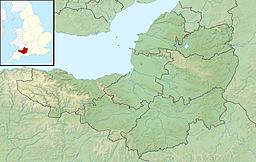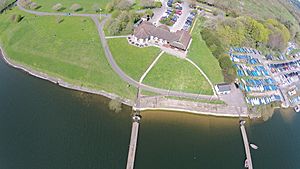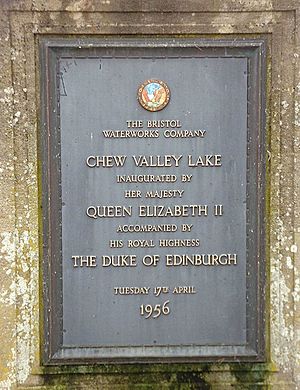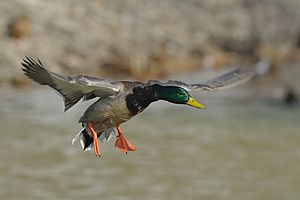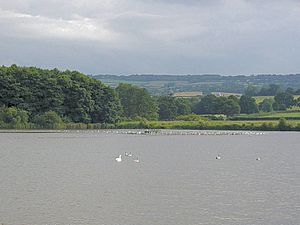Chew Valley Lake facts for kids
Quick facts for kids Chew Valley Lake |
|
| Governing body | Bristol Water |
| SSSI Ref | 1001346 |
| SPA Code | UK9010041 |
| Chew Valley Lake | |
|---|---|
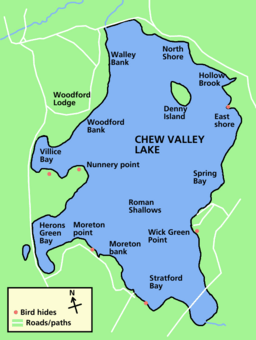
Map
|
|
| Location | Somerset |
| Coordinates | 51°20′4.92″N 2°37′4.92″W / 51.3347000°N 2.6180333°W |
| Lake type | Reservoir |
| Primary inflows | River Chew |
| Primary outflows | River Chew |
| Catchment area | 14,000 acres (57 km2) |
| Basin countries | United Kingdom |
| Surface area | 1,200 acres (4.9 km2) |
| Average depth | 14 ft (4.3 m) |
| Max. depth | 37 ft (11 m) |
| Water volume | 4,500,000,000 imp gal (0.020 km3) |
| Islands | Denny Island |
Chew Valley Lake is a very large reservoir in the Chew Valley, Somerset, England. It is the fifth-largest artificial lake in the United Kingdom and the biggest in south-west England. The lake covers an area of 1,200 acres (4.9 km²).
This lake was built in the early 1950s and officially opened by Queen Elizabeth II in 1956. It provides a lot of the drinking water for the city of Bristol and the areas nearby. The water comes from the Mendip Hills. Some of the lake's water also helps keep the River Chew flowing.
Before the lake was made, archaeologists explored the area. They found signs that people had lived there since the Neolithic (New Stone Age) period. They even found Roman items. Chew Valley Lake is now a very important place for wildlife. It is called a Site of Special Scientific Interest (SSSI) and a Special Protection Area (SPA).
The lake is a famous spot for birdwatching, with more than 260 different bird species seen there. Many native and migrating water birds visit the lake all year round. There are also two special nature trails for visitors to explore. The plants and animals here create homes for some rare plants and insects.
The lake is owned by Bristol Water. They allow some fun activities like dinghy sailing and fishing, mostly for trout.
Contents
Exploring Chew Valley Lake
Chew Valley Lake is located in the Chew Valley, right at the edge of the Mendip Hills. It is surrounded by green fields and forests. Nearby villages include Chew Stoke, Chew Magna, and Bishop Sutton.
When the lake was built in the 1950s, it was filled with 4,500 million imperial gallons (20,000,000 m³) of water. This water came from the Mendip Hills, which is an area of 14,000 acres (57 km²). The lake is not very deep, averaging 14 ft (4 m) at its highest level. Its deepest point is only 37 ft (11 m). Small rivers feed the lake, and its water then flows into the River Chew. This river travels for 17 miles (27 km) before joining the Avon and heading out to sea.
The deepest part of the lake is close to the dam and the water outlet tower. Here, the shores slope steeply, making the water up to 20 ft (6 m) deep. There is also a wooded island called "Denny Island" that is always above the water. It provides a safe home for wildlife.
Bristol Water owns and manages the lake. They created it in 1956 because the nearby Blagdon Lake could no longer meet the demand for water. Bristol Water works with groups like the Avon Wildlife Trust to protect nature and make the lake a great place for visitors.
The lake has two nice picnic areas. There is a tea shop with indoor and outdoor seating, offering lovely views of the lake. You can also find an information centre, a souvenir shop, and a small art gallery.
There are two nature trails to enjoy. The Grebe Trail is a smooth, all-weather path, perfect for walking, pushchairs, and wheelchairs. It is 0.75 miles (1.2 km) long and starts and ends at the wooded picnic area. The Bittern Trail is a grassy path that can be reached from the Grebe Trail by a footbridge. It is sometimes wet in winter, but there is a boardwalk. This trail goes along the east shore, passes a bird hide, and returns to the footbridge, making a 1-mile (1.5-kilometre) loop. Bristol Water has rules for visitors, especially about where dogs are allowed.
Getting to Chew Valley Lake
Some areas near the water are restricted to protect the wildlife. The paths around the lake are mostly flat. Where paths are paved, people using wheelchairs can easily get around.
Visitors are encouraged to use public transport, but most people arrive by car. There are plenty of parking spaces available. You can also take the "Chew Valley Explorer" bus route 672/674 to get there.
In 2002, a safe 1.9-mile (3-kilometre) cycle path was opened along the B3114 on the western side of the lake. This path is part of the West Country Way, National Cycle Network Route 3, which goes from Padstow to Bristol. It has an all-weather surface, making it smooth for walkers, people with mobility challenges, and cyclists of all skill levels. This path was funded by Bath and North East Somerset Council and other groups. Many cyclists also use the smaller roads around the lake.
Bristol Airport is about 10 miles (15 km) away. The closest main road is the A368, which runs along the southern edge of the lake. This road connects to Bath and Weston super Mare. The A37 and A38 are a bit further away and lead from Bristol. You can also easily reach the lake from the M5 motorway at junctions 18 and 22. Just follow the signs to Bristol Airport. Parking is available at the visitor centre and Woodford Lodge for a fee. Some smaller parking spots around the lake are only for people with fishing permits.
History of Chew Valley Lake
The land now covered by Chew Valley Lake was once rich farmland. Farms and houses had to be moved before the area was flooded. Sometimes, during dry summers, old roads, hedges, and tree stumps can still be seen when the lake level drops.
Before the reservoir was flooded, archaeologists did a lot of digging from 1953 to 1955. They found proof that people lived here during the Old Stone Age, Middle Stone Age, and New Stone Age. They also found items from the Bronze Age and Iron Age. These finds included stone knives, flint blades, and the head of a mace. They also uncovered old buildings and graves. These ancient items are now kept at the Bristol City Museum and Art Gallery.
Archaeologists also found Roman remains, showing that people farmed and worked in industries here from the late first century to the third century AD. At Chew Park, they discovered a Roman villa where wooden writing tablets with ink writing were found. These were the first of their kind found in the UK! The tablets were sent to the British Museum, but other Roman items are on display at the Bristol City Museum and Art Gallery.
More digging around the village of Moreton, which is now completely underwater, showed that it was a busy community in medieval times. They might have even found the remains of a Nunnery called Santa Cruz. During the Middle Ages, farming was the most important activity in this area. There were four flour mills powered by the River Chew. One mill, Stratford Mill, was taken apart and rebuilt at Blaise Castle Museum in Bristol. Moreton was the largest settlement and was even mentioned in the Domesday Book. When the lake was flooded, the Moreton Cross was moved to Chew Stoke Parish Church. There were also lime kilns used to make mortar for building churches. Farming continued until the lake was flooded, with most families also raising pigs. There were also orchards growing apples, pears, and plums. In the 18th century, Moreton also had a gunpowder mill.
Building the Reservoir
Plans to build the reservoir were discussed even before the Second World War. An Act of Parliament for the Bristol Waterworks Company was passed in 1939. After this, the company bought farms, and the previous owners continued to farm them as tenants. Any farms or buildings still privately owned were bought by the company through a special process.
Construction was approved in 1949, and a company called A.E. Farr started work, employing 300 people. The main dam was made strong by injecting concrete into cracks in the rock beneath it. The middle part of the dam was made of special puddled clay mixed with sand. This was a new way to make dams stronger.
The lake was officially opened by Queen Elizabeth II and Prince Philip on April 17, 1956. They unveiled a special stone and plaque, which you can see from the dam. The lake wasn't completely full until February 25, 1958.
During a big storm on July 10, 1968, the lake gained an extra 471 million imperial gallons (2,140,000 m³) of water. The water level rose 19 inches (480 mm) in less than 12 hours.
Wildlife at Chew Valley Lake
Chew Valley Lake is a very important place for nature. It is a Site of Special Scientific Interest (SSSI) and a Special Protection Area (SPA). This is because of the many different kinds of plants and animals that live there. Most of the area around the lake is also part of the Mendip Hills Area of Outstanding Natural Beauty (AONB), which gives it even more protection.
Birds and Their Life Cycle
More than 270 types of birds have been seen at Chew Valley Lake. It is a very important place for wildfowl that spend the winter here or are migrating. From late July to February, you might see up to 4,000 ducks of twelve different species. This includes many northern shoveler and gadwall. Up to 600 great crested grebes gather here in autumn to shed their old feathers. Scientists have been studying and "ringing" birds here since 1964 to learn more about them.
Many other birds visit, especially during spring and autumn migration. Sand martins arrive early in March, flying over the water to catch insects. You can often see groups of tits, swallows, and terns. Waders like lapwings and dunlin come to the muddy shores if the water level drops in autumn. In midwinter, up to 55,000 gulls, mostly black-headed gulls, may be resting here. Many reed warblers and sedge warblers build nests in the reeds around the lake, along with grebes and Eurasian coots.
Bristol Water works hard to help ducks breed at the nature reserve. Small numbers of tufted ducks, common pochards, common shelducks, and gadwalls raise their young here most years. Recently, water rails and Cetti's warblers have also successfully bred here.
There is also a wetland reserve called Heron's Green Pool, across the causeway from the lake. It has a shallow pool with sedges, rushes, and reedgrasses. This area is surrounded by lightly grazed grassland and attracts birds like snipe and lapwings.
Fish and Their Reproduction
In late summer, large groups of young roach and perch gather near the edges of the lake and in the weed beds. These young fish are hunted by brown trout and rainbow trout. Chew Valley Lake also has many pike, and you can fish for them at certain times of the year.
Insects and Their Life Cycle
Tiny aquatic midges are a big part of the insect life in the lake. The trout eat these midges and water boatmen from the surface. They also eat caddisfly larvae and pupae from under the water. When adult caddisflies appear, trout will eat them too. Other water creatures like daphnia and snails also live in the lake.
Many dragonflies live at the lake, including the migrant hawker and many ruddy darters. Eleven types of wainscot moths live in the reed beds. These include the brown-veined wainscot and the silky wainscot.
Plants and Their Growth
The lake is surrounded by reedbeds, carr woodland (a type of wet woodland), and grassland. These areas are managed by Bristol Water. The water in the lake is rich in nutrients from nearby fields and streams.
There are not many plants growing in the open water. You might find fennel pondweed, lesser pondweed, and water-crowfoot. In the neutral soils around the lake, you can see pepper-saxifrage and devil's-bit scabious. On the chalky soils, you might find fairy flax and salad burnet.
The fields around the lake are usually separated by hedges, and sometimes by groups of trees or woodlands. Some of these date back to medieval times. You will see many mature oak and ash trees. There are also some Scots pine and chestnut trees. Sadly, many elm trees in this area have been lost.
The Life for a Life Charity has planted four areas of woodland with 157 trees around the lake, near the restaurant. These forests include Scots pine, English oak, rowan, and silver birch trees. People can place the ashes of their loved ones beneath these trees.
Fun Activities at Chew Valley Lake
The lake is a popular place for many different leisure activities.
Birdwatching
From 2005 to 2006, Bristol Water started to rebuild two artificial islands. These islands are meant to be safe places for many different wildfowl to nest and rest. If you are a member of a birdwatching or nature society recognized by Bristol Water, you can get a permit (for a fee) to enter the reserve. This permit allows you to use the access roads, paths, and bird hides. You can get these permits from Woodford Lodge.
Sailing
The Chew Valley Lake Sailing Club has a sailing area that is about 1.9 miles (3 km) long. It is used for dinghy sailing. The lake is split into two areas: a smaller area for summer (during fishing season from mid-March to mid-October) and the full area that can be used in winter and on Sunday afternoons. The sailing area is marked by small white buoys. Racing marks are red buoys with flags.
The club can host over one hundred boats and holds big national events. For regular club races, different types of dinghies start together, like the Flying Fifteen (keelboat), Laser (dinghy), Solo (dinghy), and Topper (dinghy). There is also a handicap race for other boats. Five slipways make it easy to launch boats. The clubhouse has large changing rooms, hot showers, hot food on weekends, a bar, and a terrace overlooking the lake. The club also has facilities for disabled people, including a lift. They offer Royal Yachting Association sailing courses for members, including race training and youth training.
Fishing
Bristol Water manages fishing in the lake. You need a permit to fish, and there are specific areas where you are allowed to fish. You can also book motor boats for fishing.
See also
 In Spanish: Lago de Valle Chew para niños
In Spanish: Lago de Valle Chew para niños


